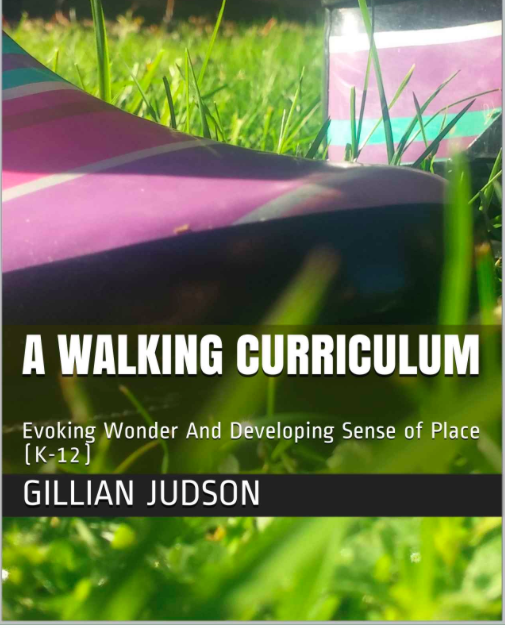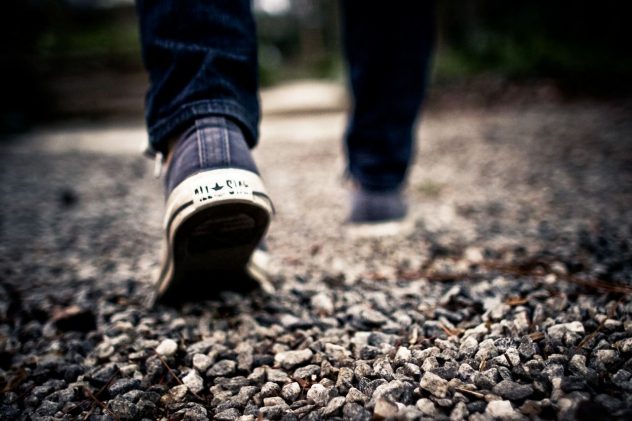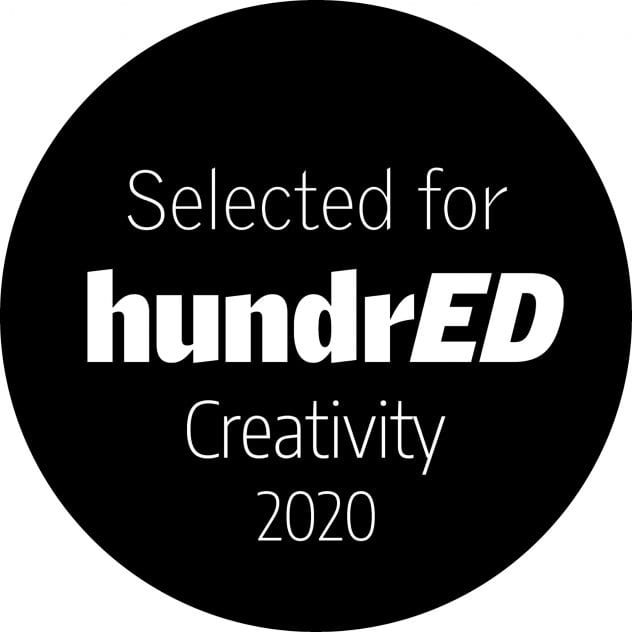We learn a place and how to visualize spatial relationships, as children, on foot and with imagination. Place and the scale of place must be measured against our bodies and their capabilities.
(Snyder, 1990, pp. 98-99)
A Walking Curriculum
Now available on Amazon markets worldwide.
Also available in SPANISH and FRENCH
In CANADA? Purchase from the Outdoor Learning Store and support Canadian NonProfits!
NEWS
- The Walking Forward: Learning From Place resource is now available! Co-authored by Heidi Wood and Gillian Judson, this resource applies an Indigenous lens to walking practices and shares the spiral-inquiries of 14 educators that employ imaginative and ecological pedagogies to teach learners about the First Peoples Principles of Learning.
If the message of this resource was a hashtag it could be #getoutside. The simple act of taking a walk—a walk with a curricular focus or purpose—can have multiple positive consequences—many of which are much more profound than we ever imagine. For example, walking can support students’ health and wellbeing by getting them moving. It can also emotionally and imaginatively engage learners by changing the “context” of learning (“context” meaning both location and the form of attention and involvement required of students).
 On a deeper level walking-based practice connects curriculum topics with/in the real world. A new level of curriculum relevance can emerge for students as a result. Going even deeper, walking-based practice can support students in developing a sense of Place. Sense of Place, here, refers to an emotional connection to some aspect of the wildness in the world that surrounds them. Sense of Place involves a sense of community. Sense of Place is what can change how our students understand the world of which they are part—it can help them re-imagine their relationship with the natural and cultural communities they live in (Judson, 2010, 2015).WA
On a deeper level walking-based practice connects curriculum topics with/in the real world. A new level of curriculum relevance can emerge for students as a result. Going even deeper, walking-based practice can support students in developing a sense of Place. Sense of Place, here, refers to an emotional connection to some aspect of the wildness in the world that surrounds them. Sense of Place involves a sense of community. Sense of Place is what can change how our students understand the world of which they are part—it can help them re-imagine their relationship with the natural and cultural communities they live in (Judson, 2010, 2015).WA
The Walking Curriculum provides us with easy-to-use, child-centred and developmentally appropriate activities that make outdoor learning – regardless of whether you’re surrounded by trees or concrete – memorable, meaningful and fun. (Karen Hiscott, Principal)
This Walking Curriculum challenges teachers to re-imagine how they teach and it encourages teachers to personally re-connect to Place and community. The #getoutside message involves acknowledging that our communities—natural and cultural—are teachers, too. This Walking Curriculum breaks down concepts of “school” that keep students inside and inactive. So, this book offers practical strategies and examples, but, more profoundly, it encourages teachers to have a new outlook on their teaching. It will empower teachers to #getoutside (physically outside and, figuratively, “outside” by rethinking how they engage their students). It invites teachers to grow beyond the book within an online community of K-12 imaginative ecological educators.
NEW! Watch THIS webinar (April 20, 2021) on Imaginative Ecological Education and the Walking Curriculum to learn more. (Thank you to the Outdoor Learning Store for offering this Spring 2021 learning series!)
Doing the walks has been highly motivational for me as a teacher and a life-long learner. (Courtney Robertson, Vice Principal/Teacher)
#getoutside today
The Walking Curriculum is readily useable for teachers K-12. The activities described can be easily adapted and used in all contexts—limited additional time and/or resources are required. It reflects principles and practices of Imaginative Ecological Education as it offers walking activities that engage student imagination and cultivate emotional connection with place. 
The 60 walks provided in the resource reflect a variety of themes, perspectives, and motivations. For example, students may be asked to find things (such as shapes, spaces or lines, evidence of growth or change, “the best” hiding places), to change perspectives (imagine being a beetle, a detective, or a visitor from outer space), to encounter the world differently (emphasizing one sense over another or moving through space differently), or to seek evidence of human-nature relationships. In all activities, the aim is to deepen awareness of the particularities and meaning of place.
Walking activities are designed to
- engage the body, emotions, and imagination in ways that can increase familiarity with the local and natural contexts of school and learning;
- increase attention to detail, particularity and their connection with place;
- connect Place-based learning activities with cross-curricular goals;
- serve as examples for your own, place-inspired teaching ideas.
Want more information? Click HERE for 5 Sample Walks from the Walking Curriculum and recent posts on the Walking Curriculum (PreK through Higher Education) by practitioners.
FREE journal to support your Walking Curriculum work/outdoorlearning.
Feedback From Teachers
The Walking Curriculum has been one of the best ways for my Immersion Kindergarten students to retain vocabulary. (Andrea Koch, Teacher)
I took my class (Grades 3/4) and another class (Grades 1/2) for the “shapes walk” on Tuesday through the wooded ravine area and neighbourhood near our school. I gave them a handout, and after a brief discussion/instruction period, away we went. We have been on many walks, but this one was very different. The other teacher and I could not believe how engaged they were (and this is not an easy group). They noticed things they had never noticed before. They saw the diamonds in the metal that covered the wood bridge. They saw the rectangles in the stairs; one of my students ‘saw the leaves that represented stars’. They decided to make another chart on the back to show the shapes they saw that were not on the original chart. It was fantastic! I look forward to trying the other walks. (Dina Lenning, Teacher)
The Walking Curriculum sparks new imaginative ways to develop sense of place and allows for deep cross-curricular connections through many hands-on explorations and discoveries. It is an engaging resource that encourages students to authentically connect with their environment. (Jolene McFadyen-Nein, Teacher)
MORE REVIEWS ON AMAZON!
In this video, educator Paula Huddy (@littlephz) shares her experiences employing the Walking Curriculum with her students.
Global Recognition!
The Walking Curriculum was selected as a top global innovation by HundrED and the Lego Foundation! Learn more about the 2020 Creativity Spotlight global collection.
Supplementary Resource
Playing In The Muck And Other Arty Stuff: Imaginative Art Activities For The Walking Curriculum
By Adelle Caunce
References
Judson, G. (2015). Engaging imagination in ecological education: Practical strategies for teaching. Vancouver, B.C.: UBC Press.
Judson, G. (2010). A New approach to ecological education: Engaging students’ imaginations in their world. New York: Peter Lang.
Snyder, G. (1990). The practice of the wild. San Francisco: North Point Press.
*I acknowledge that the Place-based, ecological practices outlined in the Walking Curriculum align with practices that have been at the heart of Indigenous worldviews since time immemorial. I am actively working with my Indigenous colleagues to expand my understanding of Indigenous ideologies and to authentically interweave the imaginative ecological learning activities in the Walking Curriculum with First Peoples’ Principles of Learning.



Gillian, I’ve been browsing through all of the different types of walks you provide here and can’t wait to share with my teachers. This is an amazing resource!! Thank you so much for creating all of these different types of walks (beyond my imagination!) and sharing them. Wow.
HI Carla! Thanks for checking it out. Would love your teachers’ feedback. Please keep me posted 🙂
I think moving is such an important part to education! Even if it is just moving around the classroom or building! Education is stuck on tests and what we have always done! I had a student tell me yesterday that after three weeks of school he has done more labs than any other science class and probably all of them together! That is not good! Needs to be addressed!
Hi Gillian,
We started trying your Walking Curriculum activities last year, first with our school staff so that they could experience the benefits, and then with our K-Grade 5 students. Some of the teachers have chosen to pursue further adventures outside this fall, and I would love to be able to send you some of their photos. Can you let me know the best way to send them?
I welcome hearing about your experiences 🙂 Hope everyone is learning and having fun.
This is an extra revision/editing exercise that I like to use if the weather is nice and if the students need to focus their argument in their own minds and really own it. I have been doing it since Spring 2015. I ask them to walk, in pairs, to the randomly selected location with one person talking about their paper on the way out and switch so the other person can talk on the way back about their own paper. The only responses that are allowed are:
• I don’t understand. (ask for clarification)
• Oh that’s good. (show support)
• Why is that? (ask for backing)
The following are tear offs that I cut up and fold in half to allow a random drawing by randomized pairs. I try to save some closer locations for mobility impaired students.
1. Walk to The Bell Tower and back
2. Walk around the Education Building and back
3. Walk to Dunkin @Thurstin and back
4. Walk around the student union and back
5. Walk to The Library and back
6. Walk to the Carolin Dining Hall and back
7. Walk around this building completely twice and back
8. Walk to The Campus Bus depot and back
9. Walk to McFall Hall and back
10. Walk to the corner of Thurstin & Wooster and back
11. Walk around the Technology College and back
Following the walk this question is on the board for their journals: Having talked with your classmate about your composition what areas will you address first in your composition and why?
i am just an ABD but I think this is valuable work and would love to have further conversations about it.
Thanks for sharing this Joseph. I hope you enjoy looking at the range of walking-based activities–PreK through high school so far. Tell me, how do your students enjoy this particular activity? Do they feel more focused? How does the activity make them feel?
Hello Gillian,
I apply a version of walking curriculum in my first year university writing studies classes at the University of Alberta in Edmonton, AB, and it has multiple wonderful effects. So glad to discover your book on it as well for the K-12 context, but I wanted to say that these ideas apply to all age groups and diverse contexts. I often (and often impromptu as needed) get my students to leave their cell phones and everything else in the classroom and go walk and talk outdoors (weather permitting) with a randomly assigned partner about a current project or question about writing–and come back with something to share. It’s always ‘tasked’ and ‘timed’ (often 15 minutes in a three hour class; 5 minutes in a shorter class) to keep things on track, and they build great rapport with classmates this way. Writing and cognition are physical acts; it’s about blood and neurons and muscles–and sunshine and air and place. Movement aids learning; we’ve always known this. And it fits with de-colonizing teaching spaces and connecting with the land. Onwards! And thank you again for your contributions to these ideas. Very widely applicable.
Thanks for your comment Christine. I HEAR YOU about applicability in Higher education–have you seen the posts on the blog all about post-secondary walking-based teaching practices? I have contributed some as have some of my imaginaitve colleagues around the globe. The book is K-12, but I am hoping to do another one (perhaps a collection of professors’ stories) for Higher ed. Perhaps you would be interested in contributing? Exciting developments too with the walking practice and Aboriginal education. I am excited that the conversations are happening and the book is provoking these. As you know, these arent just activities…more a way of teaching/being. A method…Would you consider doing a post for imaginED on your higher ed walking practice? The example you shared here is cool. Email me! [email protected]
Much of this (especially connection to the land and sense of place) sounds quite close to the teachings by Indigenous peoples in Canada that have been shared out over the last few decades. I am curious as to what from here has been learned from First Peoples’ teachings, and if credit has been given to them.
Hi Jo,
I really appreciate your comment. Yes. 100% agree with you that Place-Based Western ideologies/pedagogies (a small part of Western thinking) reflect key aspects of Indigenous ideologies/pedagogies. To your question: Yes! I’m currently working with an Indigenous educator (the great Heidi Wood) to reframe the walks through an Indigenous lens and we have collaborated on a Surrey-based inquiry project that interweaves the walking themes with FPPLs. This has been wonderful learning experience for me. I’m pleased to share that in connection with the Network of Inquiry and Indigenous Education, we are putting together a resource that exemplifies the connections and celebrates the inquiry we did with those teachers.
What are some examples of activities included in the Walking Curriculum, and how do they engage students’ imagination and emotional connection to place?
How can the Walking Curriculum be adapted and used in various educational contexts, from PreK to higher education like Tel U ?
Hi there
Some ideas of expanded usage here: https://www.educationthatinspires.ca/walking-curriculum-imaginative-ecological-learning-activities/walking-curriculum/
For larger context you might read more about Imaginative Ecological Education!